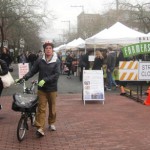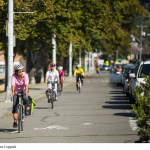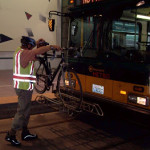The first item on the National Bike Summit schedule for the afternoon of Monday, March 4 was “orientation and state meetings.” Not sure what to expect, I found the sign that said “WA” and joined the Bicycle Alliance’s Barb Chamberlain and Blake Trask at the Washington table. Also there were Evan Manvel and Chuck Ayers from Cascade Bicycle Club, Alta planner and League board member Steve Durrant, Carolyn Moulton of Bikespot in Anacortes, and Washington Bikes board member Brian Foley of REI. Policy staff from the League presented three “asks” (specific requests) we would be taking to meetings with Congress in a few days. Then a young woman who worked in a congressional office shared her tips for getting staffers on your side. And it was thusly I learned that 25 year olds in Banana Republic act as gatekeepers to elected officials.
As soon as the presentations wrapped up, the people at the Washington table started talking rapid fire about scheduling meetings and the characteristics of the two senators and seven representatives whose offices we would be visiting. We had been charged with inviting each elected on a ride to see some bike-related project in her/his district, and as the professional advocates around me brainstormed ideas, I was awed by their breadth of knowledge. They knew details about each district in the state, and I’m sure I don’t even know about all of Seattle’s bike features. Listening in helped me see that working in policy involves a careful weighing of a politician’s known preferences with the agenda you represent, and that means learning as much as you can about a given figure. To show the connections between their aims and politicians’ positions, advocates use strategic language and framing. The “bicycling means business” theme of the Summit had been chosen, perhaps, to speak to the concerns of a Congress beleaguered by budgetary conflicts. When we went to Congress, we were marketing bicycling as an economic booster not least of all because this was the message deemed most likely to stick.
All of this was new to me. I have a lot of experience talking about my academic work at conferences, but trying to demonstrate your aptitude as a thinker is a very different project than trying to demonstrate the value of your cause to people who may not even share your values. And though I learned a lot about influencing policy during the two year period I helped strategize CicLAvia in Los Angeles, my skills were rusty. I was happy to tag along and see how the others handled lobbying, and after our first few chats with staffers, I even chimed in about how bike projects benefit a broad population of people who use bicycles.
That was a day away, though, and as we all moved into an even larger ballroom for the opening dinner, I got to continue talking to people who already supported bicycling. By this time, I understood that chatting was an opportunity to practice translating my ethnographic insights into something useful for advocates. I would try out an “elevator speech” on one person, see how my words were received, and then try a revised version on someone else. The project I talked about the most was the Bicicultures Roadshow, an experimental conference in April I’m co-organizing that focuses on crossovers between bike research, advocacy, and community.
The dinner was quite a showcase, starting with the very dapper mountain biking legend Gary Fisher taking the seat next to me. Once I got over the shock that he’s a real person and not just a name on a downtube, we talked about how my Bicicultures co-conspirator, Sarah McCullough, had collected materials about him for the archive of mountain biking history online that she built. Onstage, the League President Andy Clarke talked about the organization’s move away from vehicular cycling and toward infrastructure projects, a fascinating topic that deserves much more discussion. More speeches followed, most notably from Secretary of Transportation Ray LaHood. One speaker, Bruce Katz from the Brookings Institute, talked to a rapt audience about trends in urban change. I hadn’t really thought about the fact that as an urban anthropologist, I’ve read a lot of theory about space and place, while a lot of bike advocates may not be familiar with these ideas. Maybe that’s why issues like gentrification connect with bicycling for me, and maybe that’s not so obvious to others.
On Tuesday, I listened to a panel about political will for bike projects in Indianapolis, and observed advocates strategically framing their mayor as a strong leader. There was little information shared about the bike community in that city, but the mayor himself was there to receive accolades for having supported bike projects. This struck me because I’m working on a writing project that analyzes how advocates influence political will, and it reminded that it’s sometimes part of the strategy to let the politician take credit for cultural shifts that actually emerged from movement work. What I wonder is whether we end up misrepresenting culture change processes because of this.
Another thing that stood out to me from this panel was the invocation of the “creative class” theory, where bike infrastructure becomes a carrot to attract “desirable workers.” This strategy has the potential to keep bicycling exclusive rather than inclusive. First off, it frames quality public space as a commodity that should be accessible only to those who have the educational and social resources to get these creative economy jobs. Second, it frames these creatives as the intended users of bike infrastructure projects rather than existing residents of urban neighborhoods. Shouldn’t new infrastructure serve the people who live there now and not just some imagined future population? I’m not alone in criticizing the creative class concept, but sadly I saw no discussion at the Summit about the fact that many people who are using bikes now do it because it’s the cheapest way to get around. Do low-income bike users matter less? This is a tough conversation, but it should be out in the open rather than sidelined in favor of strategic language that honors political figures and potential investors.
During the day’s luncheon, we were shown an ad that proclaimed bicycling to be “for all” but showed only white people. By this time I’d noticed how few Latinos like me were in attendance at the Summit, and was feeling distinctly marginal. It was something of a relief to escape the conference site for a while and visit the National Portrait Gallery down the street. I wandered through an exhibit about the Civil War, finding my mood reflected in paintings of glowering storms looming over a divided America. At the rear of an alcove lined with tiny portraits of soldiers’ bodies flung askew on the edges of trenches, some of the first photographic images of death, I found the Gettysburg Address. I stood there for a few moments, in the nation’s capital a few days after the announcement that our elected officials could not decide whether to fund our government, after feeling invisible in crowded rooms, with the words of a man that poured all of his living energy into a fight that we’ve said was for many causes, but most of all for freedom:
Four score and seven years ago our fathers brought forth on this continent a new nation, conceived in liberty, and dedicated to the proposition that all men are created equal.
When I headed back to the Summit later on, I felt a renewed sense that in this bike movement there is room for social justice. I had been so accustomed to working on my own that I forgot that I have something in common with a lot of people who come to bicycling for different reasons, and that my critical voice can contribute to the larger movement. This fight is not separate from other fights to legitimize the humanity of all people. I’m fortunate that supportive friends have given me a platform to speak, and in return I must stay in the room and keep talking.



